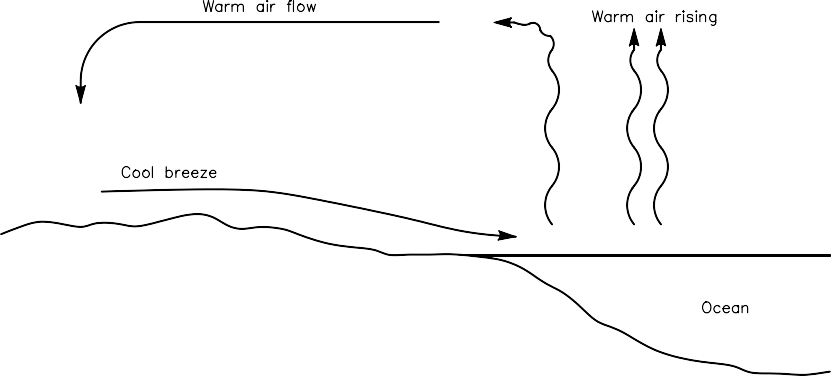Other Conditions Associated With Ducts
Certain kinds of wind may also create useful inversions. The Chinook wind that blows off the eastern slopes of the Rockies can flood the Great Plains with warm and very dry air, primarily in the springtime. If the ground is cool or snow-covered, a strong inversion can extend as far as Canada to Texas and east to the Mississippi River. Similar kinds of foehn winds, as these mountain breezes are called, can be found in the Alps, Caucasus Mountains and other places.
The land breeze is a light, steady, cool wind that commonly blows up to 50 km (30 mi) inland from the oceans, although the distance may be greater in some circumstances. Land breezes develop after sunset on clear summer evenings. The land cools more quickly than the adjacent ocean. Air cooled over the land flows near the surface of the Earth toward the ocean to displace relatively warmer air that is rising. See Fig 21.29. The warmer ocean air, in turn, travels at 200-300 m (600-1000 ft) altitude to replace the cool surface air. The land-sea circulation of cool air near the ground and warm air aloft creates a mild inversion that may remain for hours. Land-breeze inversions often bring enhanced conditions and occasionally allow contacts in excess of 800 km (500 mi) along coastal areas.
In southern Europe, a hot, dry wind known as the sirocco sometimes blows northward from the Sahara Desert over relatively cooler and moister Mediterranean air. Sirocco inversions can be very strong and extend from Israel and
 Lebanon westward
past the Straits of Gibraltar. Sirocco- type inversions are probably
responsible for record-break- ing microwave contacts in ex- cess of 1500
km (930 mi) across the Mediterranean.
Lebanon westward
past the Straits of Gibraltar. Sirocco- type inversions are probably
responsible for record-break- ing microwave contacts in ex- cess of 1500
km (930 mi) across the Mediterranean.
